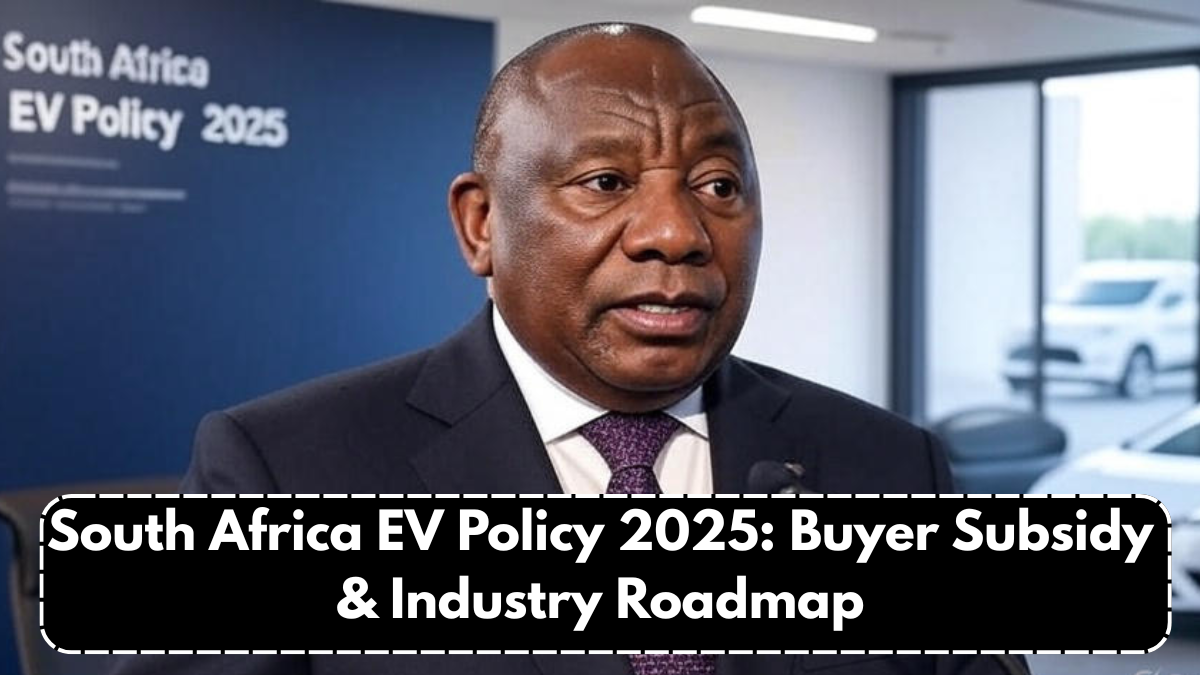Electric mobility is becoming a global necessity, and South Africa has taken a major step forward with the South Africa EV Policy 2025. Designed to support the adoption of electric vehicles, the policy highlights financial incentives, infrastructure expansion, and long-term planning for the automotive industry. For consumers, the buyer-focused subsidies bring EVs closer to affordability, while for automakers, the auto roadmap provides a clear path to a greener future.
The South Africa EV Policy 2025 is part of a wider vision to reduce carbon emissions, improve urban air quality, and align with global sustainability targets. With a focus on both demand and supply, the policy addresses buyers, manufacturers, and investors alike.

Why the EV Policy Matters in 2025
The automotive sector contributes significantly to South Africa’s economy, and shifting toward electric mobility ensures long-term competitiveness. The South Africa EV Policy 2025 introduces a balanced strategy where buyer subsidy schemes encourage consumer adoption, while an auto roadmap prepares manufacturers to adapt production lines for electric vehicles.
Key objectives of the policy include:
- Making EVs affordable through buyer subsidy incentives.
- Expanding nationwide charging infrastructure.
- Providing tax breaks for manufacturers.
- Ensuring skills development for EV-related jobs.
- Aligning South Africa with global EV adoption trends.
This combined approach makes the South Africa EV Policy 2025 one of the most comprehensive sustainability measures in the country’s history.
Buyer Subsidy Benefits
One of the biggest highlights of the policy is the buyer subsidy scheme. These subsidies reduce the upfront cost of electric vehicles, making them more accessible to the middle class.
Buyer Category |
Subsidy Range (Approx.) |
Benefit Highlighted |
|---|---|---|
First-time EV buyers |
R40,000 – R60,000 |
Encourages adoption among new users |
Fleet owners (business) |
R80,000 – R1,00,000 |
Supports large-scale fleet electrification |
Low-income households |
R20,000 – R30,000 |
Ensures inclusivity in EV adoption |
By directly lowering purchase prices, the buyer subsidy program is expected to accelerate demand significantly.
Auto Roadmap for Manufacturers
While subsidies focus on consumers, the auto roadmap in the South Africa EV Policy 2025 ensures the supply side adapts to new trends. Automakers are encouraged to invest in EV production, local battery assembly, and research into clean mobility technologies.
The auto roadmap sets clear milestones:
- By 2026: Minimum 10% of new vehicles produced must be EVs.
- By 2030: At least 30% of all vehicles sold to be electric.
- By 2035: Full integration of EV manufacturing with local supply chains.
This structured approach not only boosts production but also creates jobs and strengthens South Africa’s export potential in the EV sector.
Challenges and Opportunities Ahead
While the South Africa EV Policy 2025 is ambitious, challenges remain. Infrastructure gaps, limited local battery production, and high energy costs may slow adoption. However, the buyer subsidy and auto roadmap provide opportunities for partnerships between government, private players, and foreign investors.
If implemented effectively, this policy could make South Africa a leading EV hub in Africa, reducing dependence on fossil fuels and positioning the country for sustainable economic growth.
Conclusion
The South Africa EV Policy 2025 is a game changer for the nation’s automotive industry and environmental goals. By combining buyer subsidy incentives with a well-defined auto roadmap, the government has laid the foundation for accelerated EV adoption. The success of this policy will depend on strong implementation, but it offers a powerful vision of cleaner transport and a sustainable automotive future.
FAQs
What is the South Africa EV Policy 2025?
It is a government initiative designed to promote EV adoption through subsidies and a long-term auto roadmap for manufacturers.
How does the buyer subsidy work?
The buyer subsidy reduces the upfront cost of electric vehicles, making them more affordable for individuals and businesses.
What targets are set in the auto roadmap?
The auto roadmap includes production goals, such as 10% EV manufacturing by 2026 and 30% EV sales by 2030.
Who benefits from the policy?
Both consumers, through buyer subsidy, and automakers, through incentives in the auto roadmap, benefit from the program.
Does the policy address charging infrastructure?
Yes, the South Africa EV Policy 2025 emphasizes nationwide charging expansion to support EV growth.
Click here to learn more